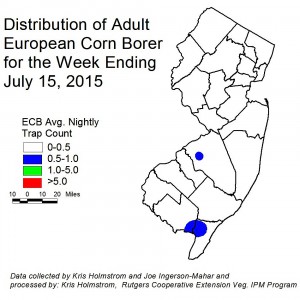Mid-July has arrived and the 2015 peach harvest season has begun in earnest. As each successive crop of fruit mature and ripen, they become susceptible to infection by the brown rot fungal pathogen, Monilinia fructicola. Since spores of this pathogen require water to germinate, the number of fruit infection periods and therefore severity of the 2015 epidemic will be very much dependent on the number of rainfalls.
Archives for July 2015
Potato | Tomato Disease Forecast 7-21-15
Click to View | Download Report 7-21-15
Potato Disease Forecasting Report
We will be tracking DSVs for Late blight development and calculating P-days for initiating the first early blight fungicide application.
The first late blight fungicide application is recommended once 18 DSVs accumulate from green row. Green row typically occurs around the first week in May in southern New Jersey. An early season application of a protectant fungicide such as mancozeb (Dithane, Manzate, Penncozeb) or Bravo (chlorothalonil) as soon the field is accessible is suggested. Please be vigilant and keep a look out for suspect late blight infections on young plants. No late blight has been reported in our region to date.
Remember the threshold for P-days is 300! Once 300 P-days is reached for your location early blight fungicide applications should be initiated. Growers who are interested in using this model should chose the location above that is closest in proximity to their farming operation and should regularly check the Cornell NEWA website (http://newa.cornell.edu/) where this information is compiled from. Click on Pests Forecasts from the menu, select your weather station, and click on tomato diseases, set accumulation start date and a table of daily and total DSVs will be generated.
Disease severity values (DSVs) for early blight, septoria leaf spot, and tomato anthracnose development are determined daily based on leaf wetness (due to rainfall, dew) and air temperature.
On a daily basis DSV values can range from 0 to 4 where 0 = no chance for disease development to 4 = high chance for disease development.
DSVs are accumulated during the production season.Fungicide applications are based on an individually determined DSV threshold. The first fungicide application for the control of these three diseases is not warranted until 35 DSVs have accumulated from your transplanting date. After that, growers can base fungicide applications on different DSV thresholds.
Vegetable Disease Briefs – 7/20/15
- There have been no new reports of late blight in New Jersey since 7/8. To track late blight in the US please visit http://usablight.org/
- Cucurbit downy mildew has been reported on cucumber in New Jersey and on cucumber and butternut squash in PA this past week. To track the progress of CDM in the US please visit http://cdm.ipmpipe.org/.
- Bacterial leaf spot is being reported on pepper and tomato.
- Basil downy mildew remains active across the region.
- Phytophthora blight has been reported on multiple crops.
- Pepper anthracnose has been reported in southern New Jersey.
Potato | Tomato Disease Forecast 7-17-15
Click to View | Download Report 7-17-15
Potato Disease Forecasting Report
We will be tracking DSVs for Late blight development and calculating P-days for initiating the first early blight fungicide application.
The first late blight fungicide application is recommended once 18 DSVs accumulate from green row. Green row typically occurs around the first week in May in southern New Jersey. An early season application of a protectant fungicide such as mancozeb (Dithane, Manzate, Penncozeb) or Bravo (chlorothalonil) as soon the field is accessible is suggested. Please be vigilant and keep a look out for suspect late blight infections on young plants. No late blight has been reported in our region to date.
Remember the threshold for P-days is 300! Once 300 P-days is reached for your location early blight fungicide applications should be initiated. Growers who are interested in using this model should chose the location above that is closest in proximity to their farming operation and should regularly check the Cornell NEWA website (http://newa.cornell.edu/) where this information is compiled from. Click on Pests Forecasts from the menu, select your weather station, and click on tomato diseases, set accumulation start date and a table of daily and total DSVs will be generated.
Disease severity values (DSVs) for early blight, septoria leaf spot, and tomato anthracnose development are determined daily based on leaf wetness (due to rainfall, dew) and air temperature.
On a daily basis DSV values can range from 0 to 4 where 0 = no chance for disease development to 4 = high chance for disease development.
DSVs are accumulated during the production season.Fungicide applications are based on an individually determined DSV threshold. The first fungicide application for the control of these three diseases is not warranted until 35 DSVs have accumulated from your transplanting date. After that, growers can base fungicide applications on different DSV thresholds.
Fruit IPM Report 7-16-2015
Peach
Oriental Fruit Moth (OFM): The third brood should be treated based on the timings below. Overall pest pressure is light with some exceptions in northern counties.
[Read more…]
Veg IPM Update: Week Ending 7/15/15
Sweet Corn
There is still very little European corn borer (ECB) adult activity at this time. Few individuals have been captured throughout NJ this past week (see ECB map). ECB infestations are absent from sweet corn plantings. We would expect to see signs of the second flight within the next week or so.
As always, consider treating when the number of infested plants in a 50 plant sample exceeds 12%. Any planting remaining at or above threshold as it proceeds to full tassel should be treated, as this is the last stage at which ECB larvae will be exposed and vulnerable to insecticidal sprays.
See the 2015 Commercial Vegetable Recommendations Guide for insecticide choices.
[Read more…]

